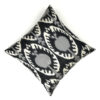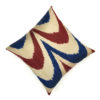75,00€ Original price was: 75,00€.50,00€Current price is: 50,00€.
50 X 50 cm.
Origin: Uzbekistan
Material: Ikat
Delivery time: Spain approximately 2-5 days, Europe 5-7 days, other continents 7-10 days.
Sold without filling
Out of stock
IKAT
What does ikat mean? The word “ikat” means “to bind.” It is a very ancient way of creating designs in fabric by resist-dyeing the threads before the fabric is woven. In Uzbekistan, villagers especially in Ferghana Valley take the weft (crosswise filling threads) and tie tiny bits of plastic onto the threads. The tightly tied areas of thread, when put into the dye pot, resist the color and create a pattern, once the plastic ties are removed. Traditional Uzbek ikat cottons are often dyed in lively and engaging motifs representing the village life and beliefs of the people. Ikats are often symbols of status, wealth, power and prestige. Modern Uzbek adras ikats in cotton and silk are brightly colored with good imported natural dyes. How does the ikat fabric differ from other fabric? Ikat fabrics are woven by hand on narrow looms in a labor-intensive process. Uzbek ikats are generally 15.7” (40 cm) to 23.6” (60 cm) wide. Handwovens, free of the chemical additives and stresses of power-loom production, are vastly different in appearance and feel from machine-made fabrics. Plain Weave ikat fabrics, due to the unique resist patterning, look the same on both sides of the fabric; there is no right side and wrong side to the cloth. The Uzbek adras ikats typically have 2” to 3” solid borders along each selvage. Many designers make use of these special qualities. How they were used? In the nineteenth century, when these fabrics were woven, they had a purpose beyond their commercial role as luxury trade goods and beyond their social functions as presentation robes and ceremonial costumes. The Central Asian ikats were made to give pleasure, to delight and entrance the viewer.
| Dimensions | 50 × 50 cm |
|---|
Only logged in customers who have purchased this product may leave a review.


 Español
Español







Reviews
There are no reviews yet.